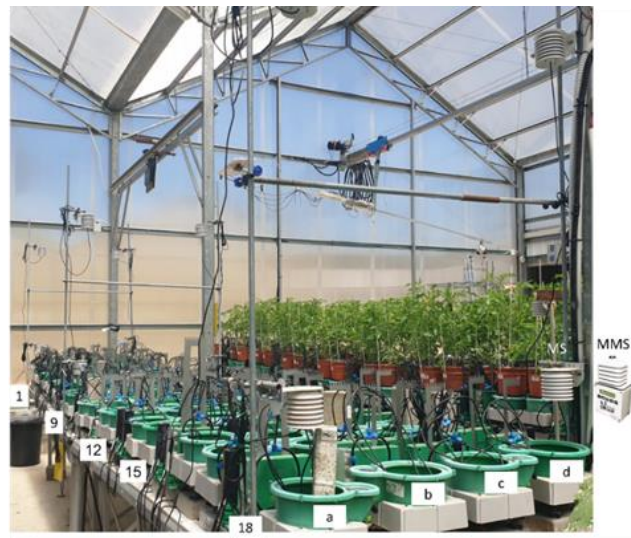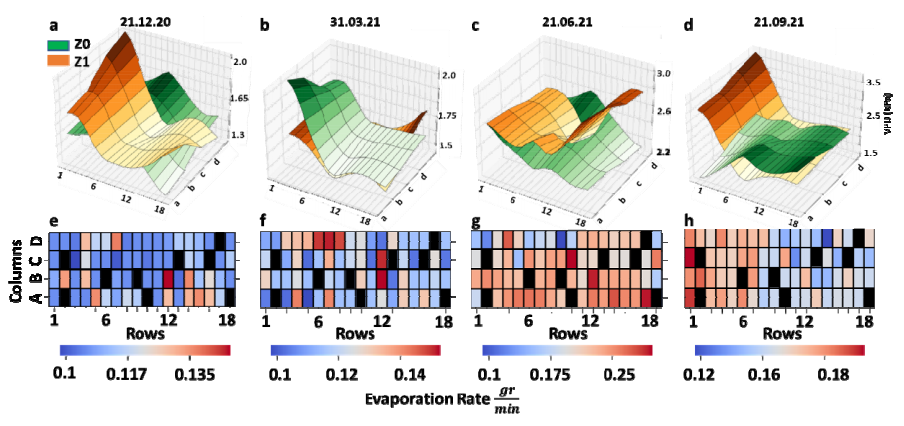品质至上,客户至上,您的满意就是我们的目标
当前位置: 首页 > 新闻动态
科学家利用Plantarray植物功能生理表型测量系统发表微气候和机器学习算法研究文章
发表时间: 点击:219
来源:北京博普特科技有限公司
分享:
最近,科学家利用Plantarray植物功能生理表型测量系统,发表了题“Evaluating Evapotranspiration in a Commercial Greenhouse: A Comparative Study of Microclimatic Factors and Machine-Learning Algorithms”的文章,所有模型中最具影响力的三个特征是光、日和小时,强调了时间维度的重要性,该方法使我们能够探索利用先进的计算方法来改善各种环境条件下水损失的估计的潜力。
评估商业温室中的蒸散量:微气候因素和机器学习算法的比较研究

摘要
FAO-56 Penman-Monteith方程(FPME)通常用于计算蒸散量和应用必要的灌溉,其基础是通常从单个测量站获取的环境数据。在这项研究中,我们假设FPME的精度受目标区域内随时间和空间变化的小气候变化的影响。因此,我们通过将 FPME的蒸散评估与全年数十台称重蒸渗仪测量的实际蒸发量进行比较,测试了商业温室中众多空间和时间环境测量点对 FPME 准确性的影响。此外,我们利用机器学习算法的功能来利用获得的大量数据来预测蒸散。我们的结果显示与蒸渗仪相比,每日FPME的准确度差异为-22%至+22%,冬季高估,夏季低估。有趣的是,每天使用更多的数据点会导致FPME评估的准确性降低。数据点数量的增加与准确性的降低之间的冲突可以用每日滞后来解释。当模型数据集包含时间参数时,机器学习算法(决策树、随机森林、XGBoost 和神经网络)在预测蒸散方面表现出令人印象深刻的准确性(2 > 0.918)。此外,我们证明空间抽样对预测准确性的影响比收集的数据量更强。具体来说,当我们使用原始数据集的 10%(3.01e5 条目)并高度考虑空间测量时,性能最好的模型(随机森林和 XGBoost)非常准确(分别为 R2 = 0.913 和 R2 = 0.935)。所有模型中最具影响力的三个特征是光、日和小时,强调了时间维度的重要性。这种方法使我们能够探索利用先进的计算方法来改善各种环境条件下水损失的估计的潜力。
关键字:
缩写:蒸发蒸腾、FAO-56 Penman-Monteith、反距离加权、机器学习

Evaluating Evapotranspiration in a Commercial Greenhouse: A Comparative Study of Microclimatic Factors and Machine-Learning Algorithms
Abstract
The FAO-56 Penman-Monteith equation (FPME) is commonly used to calculate evapotranspiration and apply necessary irrigation, based on environmental data usually taken from a single measuring station. In this study, we hypothesized that the
accuracy of the FPME is affected by microclimatic changes over time and space within the target area. Therefore, we tested the impact of numerous spatial and temporal environmental measurement points in a commercial greenhouse on the accuracy of the FPME, by comparing its evapotranspiration evaluation to the actual evaporation measured by dozens of weighing lysimeters throughout the year. Additionally, we harnessed the capabilities of machine-learning algorithms to utilize the extensive data acquired for predicting evapotranspiration. Our results revealed that
the daily FPME exhibited a -22% to +22% discrepancy in accuracy, as compared to the lysimeters, with overestimation in the winter and underestimation in the summer. Interestingly, using more data points per day led to less accurate FPME evaluation. The conflict between an increased number of data points and a reduction in accuracy was explained by daily hysteresis. Machine-learning algorithms (Decision Tree, Random Forest, XGBoost and Neural Network) showed impressive accuracy in predicting evapotranspiration, when the model dataset contained temporal parameters
(2 > 0.918). Furthermore, we demonstrated that spatial sampling had a stronger effect on the accuracy of predictions than the amount of the data collected. Specifically, when we used 10% of the original dataset (3.01e5 entries) with high consideration of spatial measurements, the best-performing models (Random Forest and XGBoost) were highly accurate (R2 = 0.913 and R2 = 0.935, respectively). The top three most influential features of all models were light, day and hour, underscoring the importance of the temporal dimension. This approach allowed us to explore the potential of leveraging advanced computational methods to improve the estimation of water loss under various environmental conditions.
Keywords:
Abbreviations: Evapotranspiration, FAO-56 Penman-Monteith, inverse-distance weighting, Machine-learning